Verdun to Étain
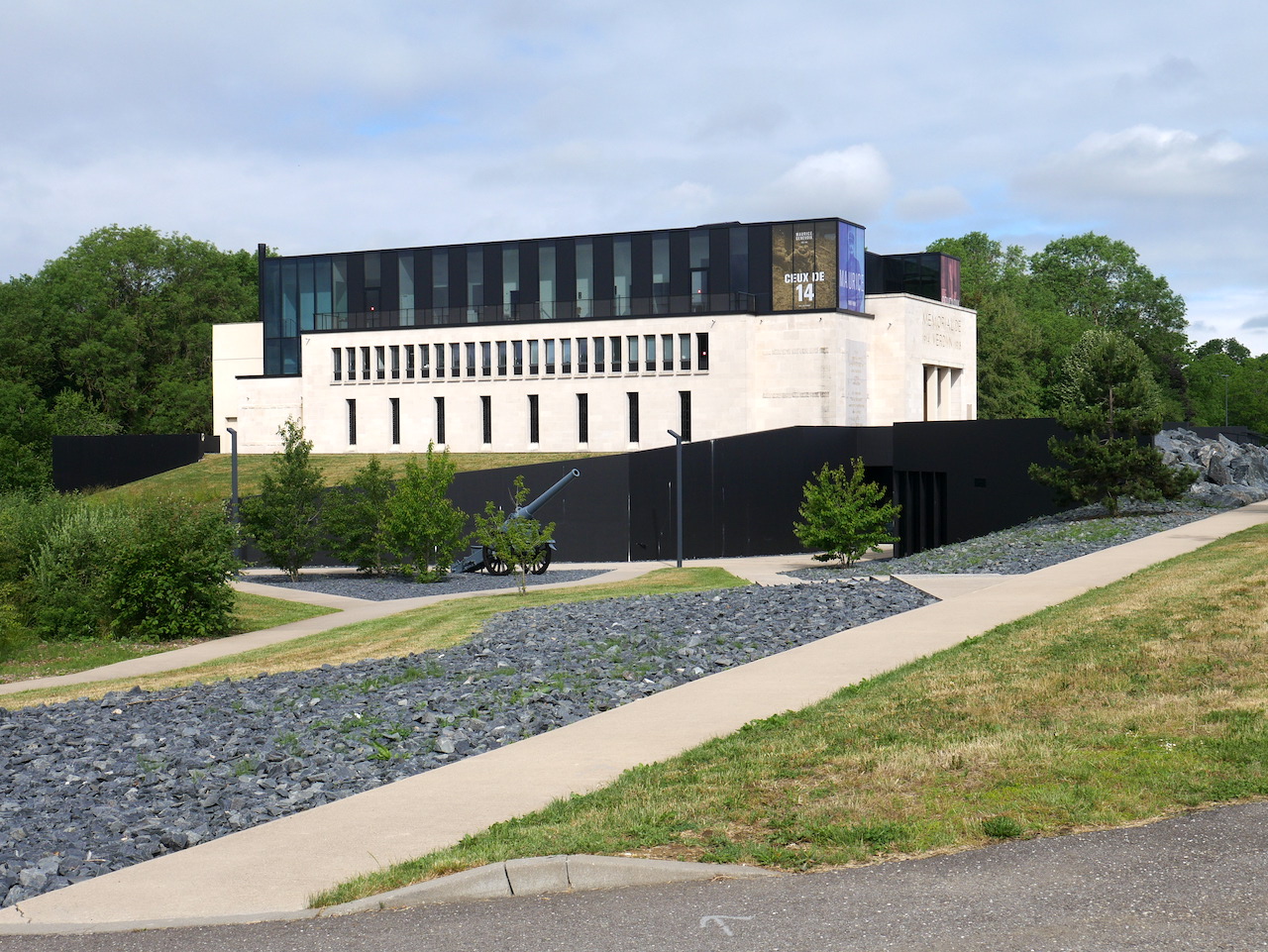
Grand Est
11. Verdun to Étain
Medium
7h30
28,5km
+321m
-332m
Step
Embed this item to access it offline
Leaving downtown Verdun you will discover the military districts before going up towards the hills, including that of Douaumont with its glorious but also destructive past in men and villages. For reasons of security and memory, it is not advisable to leave the paths in the forest. You are crossing lands ravaged by History that the vegetation is trying to make disappear. You will be doubly careful on the departmental roads that lead you to Étain.
8 points of interest

Tribunal dans les bâtiments conventuels de l’abbaye Saint-Paul - Amis de saint Colomban St ColumbanAbtei Saint Paul's in Verdun
A Benedictine abbey founded in 973, it became an abbey of the canons regular of Prémontré in 1135. This congregation was founded in 1120 by a priest, Norbert de Kanten, on land donated by the Bishop of Laon in the forest of Saint-Gobain at the place called "Presmontré".
Saint-Paul de Verdun
When it was founded, the Benedictine abbey was under the name of Saint Paul, bishop of Verdun from 626 to 648. He replaced Ermenfroy, a monk from Luxeuil who died around 625, on the episcopal see. Paul came from the abbey of Tholey in the Saarland and was at the court of Dagobert, Éloi, Ouen, Didier de Cahors and the "pupils" of Luxeuil. In the life of Paul de Verdun we talk about the eremus Vogasus, is it the Saint-Mont in Remiremont or Luxeuil? His friend Arnoul, bishop of Metz, was a hermit at the Saint-Mont.
At that time the community of Luxeuil was a reference for monastic communities of men and women in Gaul.
At present the 17th century monastery buildings are occupied by the Sous-Pérfecture and the Tribunal.
Église Saint-Jean-Baptiste à Verdun - Amis de saint Colomban TouristSaint-Jean-Baptiste Church in Verdun
The church is located on the Via Columbani leaving Verdun, in a district called "le Faubourg Pavé", this small church made of stone and wood was built, modestly, in 1884.
The church was heavily damaged during the war of 14-18, the missing half was rebuilt identically after the war.
Its interest lies in its stained glass windows financed by families of soldiers and officers, some of whom died in the church. A beautiful tribute that deserves a visit.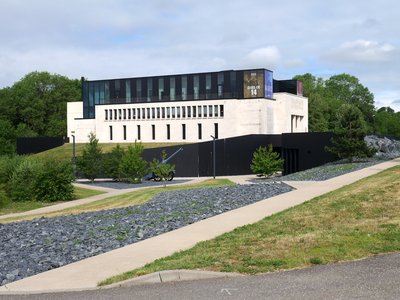
Mémorial de Verdun à Fleury-devant-Verdun - Amis de saint Colomban HistoricalVerdun Memorial - Battlefield
The hills of Verdun were bitterly disputed between the French and German armed forces. The slightest piece of land was taken and retaken with bombed villages, which became real skeletons of stone. The collective memory retains information with signposts and the location of villages whose vegetation replaces the houses. The Memorial is built on the disappeared commune of Fleury-devant-Douaumont and the postal address of the Memorial to keep the name of the village.
The Memorial was created in 1967, under the aegis of the academician and veteran Maurice Genevoix, it is one of the main European museums of the Great War. For those who seek to feel, understand and transmit what Verdun was, the Memorial is a must.
In 2016, the building has just been given a new lease of life in order to better understand this war with adapted audiovisual and didactic means.
This memorial is an essential complement to a visit to the Verdun Citadel Museum.
Further information: Verdun Memorial website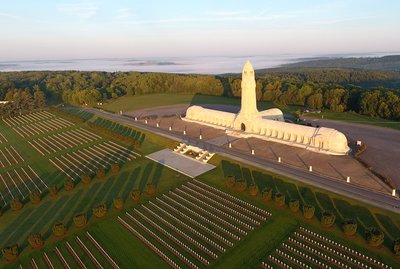
L’Ossuaire de Douaumont et la Nécropole nationale de Douaumont - www.verdun-douaumont.com HistoricalThe Ossuary of Douaumont and the National Necropolis of Douaumont
The Douaumont Ossuary, built on the site of the village of Douaumont, is a monument to the memory of the soldiers of the Battle of Verdun in 1916, located on the border of the communes of Douaumont and Fleury-devant-Douaumont.
The ossuary was designed the day after the armistice of 1918 on the initiative of Mgr Charles Ginisty, Bishop of Verdun. Inaugurated on 7 August 1932 by the President of the Republic, it houses the remains of 130,000 unknown French and German soldiers.
Opposite the ossuary, the national necropolis of Douaumont contains 16,142 graves of French soldiers.
Going around the main Necropolis, you pass the Necropolis of the soldiers of the Muslim faith who died in the Field of Honour, then you pass the monument "The Soldier of the Right" erected in honour of the deputy André Thome who was killed there.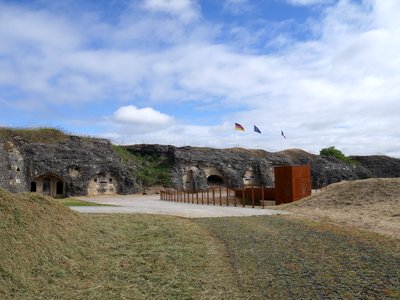
L’entrée du fort de Douaumont - Amis de saint Colomban HistoricalDouaumont Fort
After the defeat of the war of 1870 and the loss of Alsace and part of Lorraine a defence plan for the new border was drawn up. General Raymond Adolphe Séré de Rivières had a set of fortifications built along this border with 4 strongholds : Verdun, Toul, Épinal and Belfort.
Part of this line of defence, the fort of Douaumont was built on a clear mound allowing artillery fire in all directions.
The fort was conquered by surprise 4 days after the beginning of the battle of Verdun, it will be occupied for 8 months by the German army, which will make it a shelter for its troops and an essential support point to continue its offensive. Despite several attempts at reconquest, it was not until October 24, 1916 that the fort was retaken.
More information: Wikipedia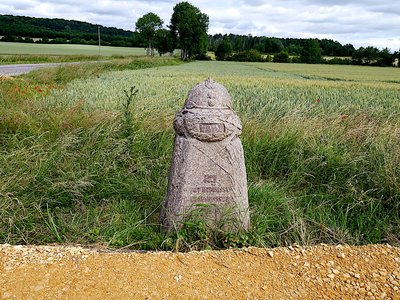
Borne symbolisant une victoire - Amis de saint Colomban HistoricalBollards on Via Columbani symbolizing the battlefields.
During your march you encounter bollards reminiscent of a fiercely disputed location between French and German troops.
Église Saint-Pierre et Saint-Paul à Dieppe-sous-Douaumont - Amis de saint Colomban TouristSaint-Pierre and Saint-Paul Church in Dieppe-sous-Douaumont
Dieppe-sous-Daumont is a martyr village of the First World War.
The Saint-Pierre-et-Saint-Paul church, built and blessed in 1738, has a 12th century Romanesque style tower, remnant of a building from that time when Dieppe-sous-Douaumont was one of the oldest episcopal provostés of the Verdun bishopric. After the Revolution, the provost was attached to the district of Étain.
The village and its church were destroyed by the bombardment of February 1916 and the area was occupied by German troops until 1918.
In 1926 a new church was rebuilt to replace a simple wooden chapel with only one of the three original bells (the other two having been buried by the inhabitants to hide them from the Germans).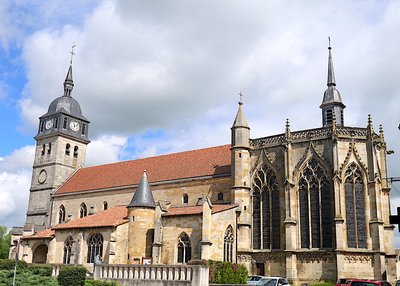
Église Saint-Martin à Étain - Amis de saint Colomban TouristSaint Martin's Church in Étain
The first church in Étain dates from the 12th century, it probably replaced an older building.
The bombings of the First World War did not spare the town and its church.
During the reconstruction of the town special attention was paid to the town hall, built in 1787, and the church, making us forget the destruction of 1916.
For the church it is worth noting that the Gothic choir, spared from the bombardments, was restored preserving all the elegance of its construction in 1437 commissioned by Cardinal Huin, a native of the country. During the reconstruction of the nave the architects were faithful to the original architecture. The ensemble presents a harmony in the styles of different periods.
Inside you will admire the Pieta made by the famous Renaissance sculptor from Lorraine, Ligier Richier.
The church is closed.
Description
From the Verdun cathedral's bedside you cross the small car park and go down the rue des Gros Degrés, rue du Pont des Augustins to the left place du Marché Couvert, rue Pasteur to the right rue Beaurepaire, cross the Meuse river, cross the place Chevet, take avenue de Douaumont, at the roundabout go straight on avenue de Lattre de Passigny, at the roundabout go straight on avenue de la 42e Division.
- After Saint-Jean-Baptiste church, third street on the left, rue du 19e B.C.P., cross Miribel avenue, rue Saint-Michel, turn right, rue du Capitaine de Vaisseau Mine, chemin des Bouillères, pass under the railroad tracks.
- Turn right at the exit of the small tunnel, follow the railway, second dirt road on the left along the small wood, straight in the wood, the road turns left and right at the crossroads in the wood stay on the main road
- At the Memorial of Fleury-devant-Douaumont take D 913, turn right on a pedestrian path parallel to D 913, second path on the left in the wood, you cross by its center the National Necropolis of Douaumont, on the right in front of the Ossuary of Douaumont, in front of the Ossuary bypass the Necropolis by your right, on your right on D 913
- On the left in front of the Memorial of the Soldier of the Right, on the right way in the wood before the carpark of the Fort of Douaumont (You can visit Fort of Douaumont and take your walk at the height of the carpark)
- Right at the crossroads with D 24, left at the crossroads with D 112, cross Dieppe-sous-Douaumont
- Go through Morgemoulin and take the D 65 towards Étain, route de Damvillers, turn left on avenue du Général de Gaulle, rue du pont you will arrive in front of the Saint-Martin church in Étain.
- Departure : Notre-Dame Cathedral, 7 Place Mgr Ginisty, 55100 Verdun
- Arrival : Saint-Martin Church, 9 rue Chanoine Bonne, 55400 Étain
- Towns crossed : Grand Est
Altimetric profile
Transport
Report a problem or an error
If you have found an error on this page or if you have noticed any problems during your hike, please report them to us here:






